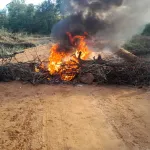WHAT’S WITH THE WEATHER?
Spring comes unsprung: Weather in SA swings from sweltering hot to bitterly cold

South Africans woke up on Sunday, elated at the Springboks’ fourth Rugby World Cup win, only to be met by wet and bitterly cold conditions over southern, central and eastern parts of the country.
Following a week of sweltering heat, with temperatures peaking well into the upper 30s in some provinces, the SA Weather Service (SAWS) predicted that South Africans are in for a prolonged spell of rain and cold temperatures – and even snow in some parts.
Last Friday, SAWS warned that, particularly on Monday and Tuesday, widespread, tropically sourced rainfall will set in over the central and eastern half of the country, with heavy falls and flooding a distinct possibility.
SAWS – the only mandated regulatory body that can issue weather warnings in the country – noted that this weather would be accompanied by a dramatic drop in daytime maximum temperatures over the eastern provinces, including Gauteng.
“Much of the highveld can expect maximum temperatures in the low teens on Monday and Tuesday, with Johannesburg likely to peak at only about 11 to 12°C. Some high-lying areas may even see single-digit maximum temperatures,” forecaster Kevin Rae said in a statement last Friday.
Along with damaging winds and severe thunderstorms, Monday saw a rare October spring snowfall in small towns in the Free State (such as Harrismith), and in the northern areas of KwaZulu-Natal and southern Mpumalanga.
What can we expect?
SAWS reported that on Tuesday, scattered to widespread showers and thundershowers are expected over the central and the northeastern areas, with cold to cool conditions remaining over the northeastern parts.
The weather service issued Yellow Level 2 warnings for disruptive rain in places over Mpumalanga, severe thunderstorms in parts of North West and Gauteng, as well as disruptive snow in parts of KwaZulu-Natal and Free State on Tuesday.
Then, on Wednesday, showers and thundershowers are expected only over the eastern areas, with most parts of the country otherwise expecting fine conditions and temperatures gradually warming into Thursday.
Is this unprecedented?
Meteorologist Annette Botha, from Vox Weather, told Daily Maverick that during this time of year – spring (the transition season) – it is usual to get this type of extreme swing of temperatures and changing weather.
“That’s why we also do get a lot of severe storms during spring, because of the changes in the atmosphere, from warm to hot – that’s one of the ingredients for severe weather,” said Botha.
Botha said that while it’s common to see thunderstorms or rain after heat waves, “this is an extreme, steep drop in temperature, and from my side, I wouldn’t be surprised if a few lowest maximum temperature records were broken either on Monday or Tuesday for the month of October in SA, because this is something that, as a meteorologist, I’ve not ever seen for this time of the year.”
And while snow is quite common for the mountainous areas of the Cape, Lesotho or the Drakensberg during spring, Botha said, “It is unusual and rare to get ground snow in towns like we’ve seen on Monday. It is definitely a very special system and it is rare for this time of the year.”
Botha added that saying it’s rare doesn’t mean it hasn’t happened before. Snow at this time of year has occurred in small towns before, mainly in the Eastern Cape and KZN.
🚨 Weather Update 🚨
Date: 30 – 31 October 2023
– More snow likely ❄️
– Severe Thunderstorms ⚡️
– WINTERY Monday and Tuesday 🥶🥶🥶#snow #hail #snowinsa #cold #snow2023 #Harrismith #southafrica #gauteng #theweathergirls pic.twitter.com/aTOmOVDz2E— Vox Weather (@VoxWeatherZa) October 30, 2023
Why is this happening?
“It’s actually two weather systems working together that’s responsible for the extreme drop in temperature and severe weather that we’ve had since Sunday,” said Botha, explaining that a high-pressure system that’s been sitting south of the country for a few days is bringing in cold air from the Antarctic, as well as a continuous onshore flow of moist tropical air.
“This [high-pressure system] is basically feeding the cut-off low weather system currently sitting over the southern Cape,” explained Botha, “and it’s also responsible for the cut-off low moving extremely slowly, and not being able to exit quickly.”
Climate change?
“I’m going to give the answer that all climatologists and meteorologists give [to the question of climate change] … that you can’t blame one small weather system on climate change,” said Botha.
“But we have seen in the past few decades that these kinds of low weather systems seem like they are keeping moisture much longer… they are stronger, they’re more slow-moving, and are producing more rain. And that’s where climate change plays a role – because it definitely plays a role.”
Read more in Daily Maverick: On the fence about climate change? We check the facts with three experts
Francois Engelbrecht, a professor of climatology at Wits University, previously told Daily Maverick, “Across the world, we are seeing an increase in the number of intense storm systems. This is very well documented.”
The Intergovernmental Panel on Climate Change’s Sixth Assessment, published in August 2021, found, “Human influence is making extreme climate events, including heatwaves, heavy rainfall and droughts, more frequent and severe.”
The reason is simple: “The warmer we make the atmosphere, the more water vapour it can hold,” explained Engelbrecht, “and therefore there’s more water available for storm systems to eventually cause precipitation… a direct consequence of a warmer world.
“This is a direct finding from a statistical analysis of the data that we have from satellites and weather stations; for the last five decades in the case of the weather stations and the last four decades in the case of the satellite data.” DM



















 Become an Insider
Become an Insider
Comments - Please login in order to comment.